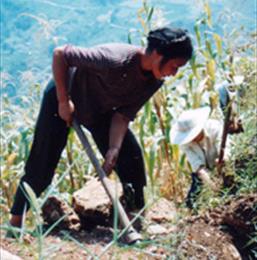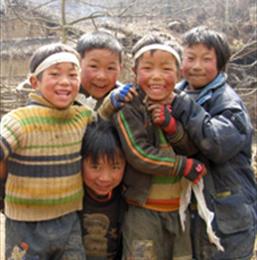Na'er Village, Hanyuan 1997-2001
Na'er Village is about a two and a half hour walk up a steep mountain from Juetuo hamlet 1. There is a road nearly all the way to the village winding up the hillside. It was built this year by the Enterprise Department. This road is very steep with hairpin bends, and needs constant repair. The village hamlets are situated on the mountain side of a valley joining the Dadu river valley. There are 5 hamlets and the houses are arranged in a nuclear fashion. Hamlet 1 is the first hamlet you come to. Hamlets 2 and 5 are a ten minute walk along from Hamlet 1. Hamlets 3 and 4 are less than an hours walk away further up the hill. Before the road was built, people had to walk over the hill tops taking three hours to get to the Township Government.
There are approximately 50 households remaining in the village. The Township figures still show 63 households, but several have moved away permanently. The population is approximately 200. The larger hamlets are 1 and 5, with 2,3 and 4 having only a handful of households each. All are Han except Hamlet 4, which is Yi and the poorest
The main sources of income are arable farming and livestock rearing, with chestnuts and walnuts being the main cash crops, supplemented by apples in hamlet 1. There is a small amount of paddy (17 mu or 1.1 ha). Of the households interviewed by DORS, all had less than 0.5mu each (15 mu equals 1 hectare). The paddy land is located below the village. Most land is steep. There is approximately 1 mu of arable land per person, although some have significantly more i.e. 4 mu and some only 0.4mu, due to changes in family size since land was contracted out. When the land was divided up there was about 1.3 mu per person
The main crops are potatoes, maize, sweet potatoes, with some rice. They exchange maize for rice, but with the road they may be able to exchange potatoes. Maize crops are damaged by wild boar and bears. Hamlet 4 does not have suitable conditions for growing maize so they grow more potatoes. Therefore they cannot raise many animals as they have no grain to feed them. There are some bee boxes in the village enough for own consumption only. The walnut and chestnut crop was particularly bad this year, so many households are in debt as they had to borrow to meet school fees and other expenditure.
Animal Husbandry:
All households raise pigs, there are several sows. Pigs are not sold out of the village as there is no transport, but now that transport is more convenient they may sell some. Pigs are reared for a household’s own consumption, and grown to a great size. Goat, cows and horses are kept. In hamlet 2, eight out of the nine households keep horses. According to the women's cadre most of the households have one or two cows. Recently 8 cows have died in the village so farmers are having their remaining cows vaccinated. Some households in hamlet 2 have more than 10 goats. Each household has a few chickens, for domestic consumption, rarely for sale.
Forestry:
They have large plots of mountain land with plentiful fuel wood - about 30 mu (2 ha) per household. Some have stands of timber trees that they can sell (transport permitting) or use themselves.
Buildings
Houses are built with a lot of wood, most are mud brick with tiled roofs and were generally spacious, with two stories and an upper balcony. Most had enclosed courtyards with several outhouses and animal sheds. Houses in hamlet 4 are mostly thatched. The school building is also mud brick with a tiled roof. Windows have frames and some mosquito netting or plastic covering. (See school building project)
Education
There is a small school in the village at hamlet 2.
All the children attend, in 1998 there were three classes being taught, pre-school, second year and fourth year. A total of 24 children attend the school. Older children go to school in Nanshan, a neighbouring village. There is only one child in middle school in the whole village, the Party Secretary's daughter. Most people have primary school education including the Yi families. Two women have middle school education. The school is in poor repair. DORS have agreed to assist Na'er Village with repair of this school. Details can be seen in our November 1998 newsletter.
Women’s micro-credit scheme
In 1998 a visit was paid to Na'er to conduct a baseline study and see whether a rural credit scheme would be appropriate, and what other assistance DORS could give. We discussed the credit scheme with the Women's Cadre (photo left), village Party Secretary and some other women in the village. We made a second visit a few weeks later to distribute loans. In a meeting with the Women's Cadre various repayment schedules were discussed. Making loans in October meant the first 6 monthly repayment would be due in April, the Women's leader was concerned that there would be difficulty making this repayment as there is no produce to sell at that time of year. Alternatives such as three repayments were discussed. The Women's leader finally decided on two six monthly repayments but with the first repayment smaller than the second. Loans were made to women in hamlet 1. They decided to form one small group. The following day at the Women's Cadres' house, loans were made to the women from the other hamlets. In total 18 women took loans. More would have borrowed if the repayment schedule was after one year rather than six monthly. Most women borrowed the maximum of 1000 RMB, and all agreed to two six monthly repayments. The management fee for each woman is 50 RMB, divided up between the two repayments.
Repayments of this first batch of loans were made in full and on time. DORS loaned to Na’er for a second time in 1999, this time 25 women took loans.
Na’er Village Primary School Rebuilding
After a request from the village DORS agreed to assist Na’er to rebuild their village primary school. The existing school had rotting roof beams and was too dangerous to use. The villagers designed a new school building, the plan for which was approved by the Township Government. DORS agreed to pay part of the funds for the school.
This project was completed in 1999.
Social and Community Forestry
Li Weixing, Na’er Village Party Secretary, approached DORS on behalf of the 156 villagers, for help in the re-afforestation of 70 mu (4.6 hectares) of their barren mountain land. Working in partnership with DORS, the villagers formulated a plan to plant the area with duzhong (Eucommia ulmoides), houbo (Magnolia officinalis), and liusha (Cryptomeria fortunei). Extensive fieldwork was carried out using participatory methodologies to ascertain the peoples’ desire for such a project and what each household/stakeholder would need from it.
The duzhong and houbo were planted for their medicinal and other non-timber forest products (NTFP) whilst the liusha, a type of cedar, will be used for house building and other domestic uses. The ratio is weighted towards liusha as the villagers are unsure about the future market for the NTFP, and were more inclined to plant the liusha for timber, even though permission is required from the County Forestry Bureau for any felling. However, they still wanted some form of economic crop. Unfortunately, due to the harsh conditions and altitude (2000+ m) of Na’er village the choice of species is very limited and so duzhong and houbo were chosen for their suitability and market potential. All harvesting of the NTFP and timber will be done within a long-term sustainable forest management (SFM) plan, which will ensure continued use and expansion of the area.
Additionally through the fieldwork carried out the villagers have asked DORS to help in devising a SFM plan for their collective woodland, which at the moment is being used on an ad hoc basis and to develop economic forestry on an individual basis in the agricultural land. The creation of an SFM plan will be an ongoing process for Na’er village through participatory forest resource assessments.
Individual development of forestry in households’ own contracted land will begin in the next planting season.
The project began in 26th February 2000
Assisting Schoolchildren - DORS Education Project
School fees – There are several children from the poorest households in the village unable to attend school. The Village Party Secretary helped to compile a list of children and DORS began providing school fees support in March 2000.
For further information on DORS education project please see Education
To follow the work on the projects in Na'er see the newsletters.
Na'er Village School Rebuilding Project
Introduction
This evaluation report is part of the ongoing monitoring of the progress of this project. DORS' contribution to the cost of the school rebuilding has now been made in full. The outline aim of the project was to replace the previously existing community-run school house, the fabric of which had deteriorated to a dangerous condition. The project was contracted out to a group of villagers, who built a new school on a site adjacent to that of the old one, which has now been demolished. The new school house has five rooms in all, three classrooms and a teacher's office, as well as a village activity room.
Photo: School teacher in Na'er
Project Organisation
The project was carried out in conjunction with the villagers of Na'er. The DORS contribution was made directly to the village Party secretary Li Weixing, to be used for the purchase of materials. Secretary Li contracted out the construction work out to a group of seven villagers. The villagers' original design was for a six-room flat-roofed earth-wall building with a total floor area of 72m². An agreement was drawn up specifying DORS' contribution to the project and how it was to be spent, with conditions attached concerning the timing and implementation of the project. This agreement was signed in November 1998. Subsequent visits were made to the village to review progress.
Project Finance
The total project cost was originally estimated as 15,000 CYN (£1,154). DORS agreed to fund the cost of those materials that the villagers would need to buy in from outside sources, namely the cement and metal reinforcing rods. The villagers agreed to provide timber, labour and transport themselves. The contract eventually signed with the village was for 4560 CYN (£351). This funding was handed over to the village in full upon signature of the contract.
Later alterations to this plan saw the villagers contract out the project to a group of seven villagers, due to the difficulty in organising voluntary labour. This contract between the village and the construction team was to the value of 12,000 CYN. This sum covered 260 days labour at 20 CYN per day, and also a number of other unforeseen materials costs not covered by DORS' contract, including lime, door and window frames, paint, glass etc. The costs of these items were to be met with further promised contributions of 2,000 CYN (£154) from Shunhe Township and 5800 CYN (£446) from the education department.
Because at the time of writing the contractors are still awaiting payment from the village for work on the project, they have not released the receipts and DORS has yet to see them. Appendix 1 contains a rough breakdown of project expenditure which is partly an estimate. DORS total project expenditure was 4,560 CYN. The cost of providing a new school for the village including an activity room was 12,000 CNY (£923 GBP), this being the value of the contract with the seven villagers who undertook the project.
Construction of Schoolhouse
Citing difficulty organising villagers to work voluntarily on the project (as envisaged in the original agreement with DORS), the Village leaders contracted out the project to a group of seven villagers. These contractors arranged the transport and storage of materials, and also did the construction work and interior and exterior finishing.
The agreed plan was modified slightly in that there are now only 3 classrooms, one office and the activity room, though the total floor area is roughly as agreed. An inspection visit paid to the school in October 1999 revealed that the completed construction work was of a satisfactory standard, all rooms had glazed windows and the exterior faces of doors, windows and their frames had been given a coat of paint. Although the roof had no guttering, a point of discussion during a visit to the site during construction, DORS was assured that water drained from the eaves into a gully below from the back of the building. An inspection proved this to be the case, with no appreciable signs of interior or exterior damp despite recent heavier than usual rains. Exterior walls had been whitewashed. Inside, each classroom had blackboards and was well furnished with chairs and desks. The village activity room however was still being used to store some furniture and equipment from the construction such as ladders.
Maintenance
There is no funding provision for maintenance out of the DORS budget, the villagers themselves will be responsible for the future upkeep of the school, as has indeed always been the case in Na'er. Maintaining the school in a satisfactory condition should be facilitated by the improved fabric of the new building, especially the concrete roof.
Villager’s reactions
Villagers in Na'er were pleased with the new school. Children at the school all expressed satisfaction with the new building, as did their teacher, and all agreed it was an improvement on the old schoolhouse.
Overall Evaluation
Overall the project has been a success. The former dangerously dilapidated school building has been replaced, and children can now attend classes without undue risk to their safety. The new schoolhouse is better able to resist the elements and is well furnished, which should ensure that the already difficult process of acquiring an education for the children of Na'er will not be made harder by the physical state of their school.
There were certain issues arising from the multi-agency funding of the project and the villager's use of subcontractors to complete construction, issues which remain unresolved at the time of writing, principally the failure of the education department to provide the funding they promised. This threatened to delay the final completion of the project to beyond the start of the autumn term, which would not have been acceptable, but in the event the contractors completed the work in time despite not being paid in full. This also led to confusion as to which funds were to be used for which items, delayed the handing over of receipts, and thus constituted a deviation from the contract originally signed with DORS, where funding was specifically allocated for the purchase of materials only. However, since that contract merely stipulated that the village was responsible for organising the work themselves, their use of funding from another agency to complete the work was not in principle a violation of its terms, despite the practical problems which this decision led to.
Appendix 1 Table of Project Expenditure
| Items | cost in CYN | Total |
| Cement 7 tonnes |
2100 |
|
| Metal reinforcing 0.6 tonnes | 2460 | |
| Lime 1.6 tonnes | 1720 | |
| Labour 260 days | 5200 | |
| Transport, timber etc |
520? |
|
| Total Project Expenditure CYN |
12,000 |
|
| Of which: DORS contribution |
4,560 | |
| Other agencies |
7,800 |


